Photo: Rich Fury/Getty Images for The Recording Academy
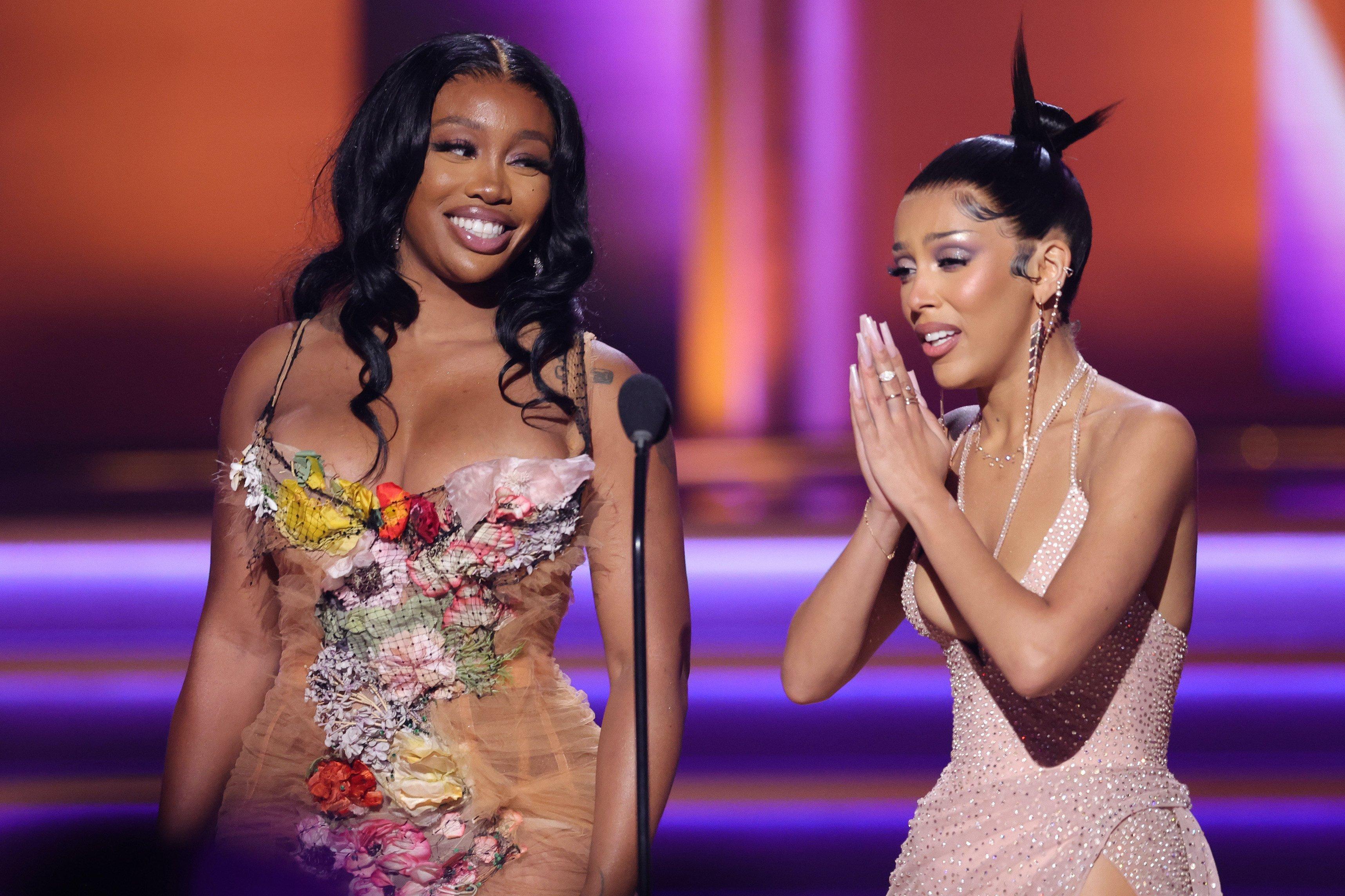
list
Watch Artists React To Winning A GRAMMY At The 2022 Award Ceremony, From Silk Sonic To SZA & Doja Cat
There were sweeps and upsets, ties and shoe-ins, but every winning artist had one thing in common: a strong reaction to getting that golden gramophone. Relive some of the most memorable acceptance speeches of the 2022 GRAMMYs.
The 2022 GRAMMYs, held for the first time in Las Vegas, were a showcase for musical excellence and raw emotion. From larger-than-life performances to powerful speeches, Music's Biggest Night was a resounding ode to the power of music to heal and excite.
But lest we forget, many artists and professionals in attendance were vying for golden gramophones in a whopping 86 categories — several of which had stiff competition. There were sweeps and upsets, ties and shoe-ins, but they all had one thing in common: a strong reaction to being awarded a GRAMMY.
Silk Sonic swept the 2022 GRAMMYs, winning in each of the four categories the duo was nominated in: Record Of The Year, Song Of The Year, Best R&B Performance (a tie with Jazmine Sullivan) and Best R&B Song. Anderson .Paak and Bruno Mars did an elated slow dance to the stage to claim their GRAMMY for Song Of The Year Award for "Leave The Door Open."
No longer a rising star, Best New Artist Olivia Rodrigo took home three GRAMMYs on Sunday night. Holding the GRAMMY for Best Pop Vocal Album for Sour, Rodrigo offered a bevy of thanks for the life-changing work.
Doja Cat and SZA made for perhaps the most memorable speech when they accepted their GRAMMY for Best Pop Duo/Group Performance for "Kiss Me More." Doja had to make a run for the stage after taking "such a fast piss," while SZA was in the complete opposite situation on crutches. They shared a sweet moment together on stage before Doja delivered a tearful final thank you.
First-time nominee Baby Keem gave a brief but heartfelt speech after winning the GRAMMY for Best Rap Performance for "Family Ties" (shared with Kendrick Lamar).
Jazmine Sullivan was nominated for three GRAMMYs and won two (including the aforementioned tie with Silk Sonic). When the 15-time nominee arrived onstage to receive the GRAMMY for Best R&B Album, she offered an honest and empowered view of her journey to create Heaux Tales.
Emotions were already running high by the time the Brothers Osborne accepted their first-ever GRAMMY for Best Country Duo/Group Performance for "Younger Me." Viewers at home couldn't see it, but it's hard to imagine that there was a dry eye in the house after their touching speech.
With 11 nominations and five wins across a wide swath of categories, Jon Batiste was one of the biggest winners at the 2022 GRAMMYs. Batiste seemed particularly humbled by his Album Of The Year win for We Are, which provided an inspiring and uplifting end to the night.
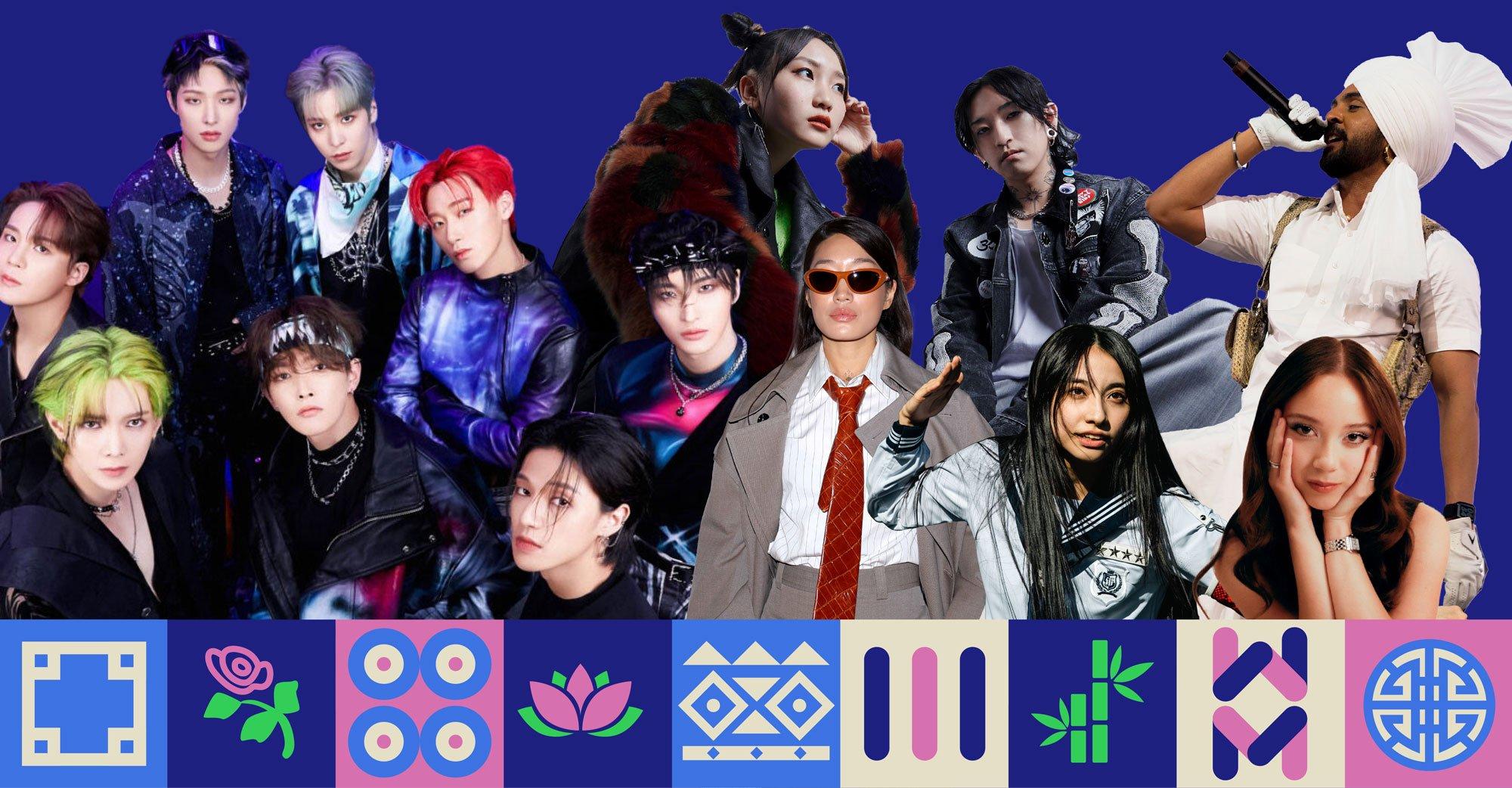
Photos: KQ Entertainment; KATO SHUMPEI; Vittorio Zunino Celotto/Getty Images; Medios y Media/Getty Images; Presley Ann/Getty Images for Coachella; Lauren Kim
news
Leap Into AAPI Month 2024 With A Playlist Featuring Laufey, Diljit Dosanjh, & Peggy Gou
Celebrate AAPI artists this May with a genre-spanning playlist spotlighting festival headliners and up-and-coming musicians. From Korean hip-hop to Icelandic jazz-pop, listen to some of the most exciting artists from the Asian diaspora.
With spring just around the corner, it’s time to welcome AAPI Month in full blossom. From rising musical artists to inspiring community leaders, it’s essential to recognize AAPI members of the artistic world and their achievements.
While AAPI Month is a U.S. holiday, the Recording Academy takes a global approach in celebrating artists and creators from across the Asian and Asian American diaspora. This aligns with the Recording Academy's growing mission to expand its reach on a global scale and celebrate international creators outside of the U.S.
Musicians of Asian American, Native Hawaiian and Pacific Islander heritage have not only helped establish the music industry, but have transformed it. From Diljit Dosanjh being the first artist to play a Coachella set entirely in Punjabi to Laufey winning a GRAMMY for her jazz-inspired pop, AAPI artists continue to influence music by both honoring tradition and reshaping modern standards.
It’s thrilling to see AAPI musicians continue to take centerstage — from Atarashi Gakko! to Tiger JK’s memorable sets at Coachella, to surprise appearances from Olivia Rodrigo, Dominic Fike, and Towa Bird. As festival season gets underway, examples of the AAPI starpower from every corner of the world abound.
As one of many ways to celebrate AAPI Month, listen to the GRAMMY.com playlist below — as a reminder to give AAPI musicians not just their May flowers, but their flowers all year-round!
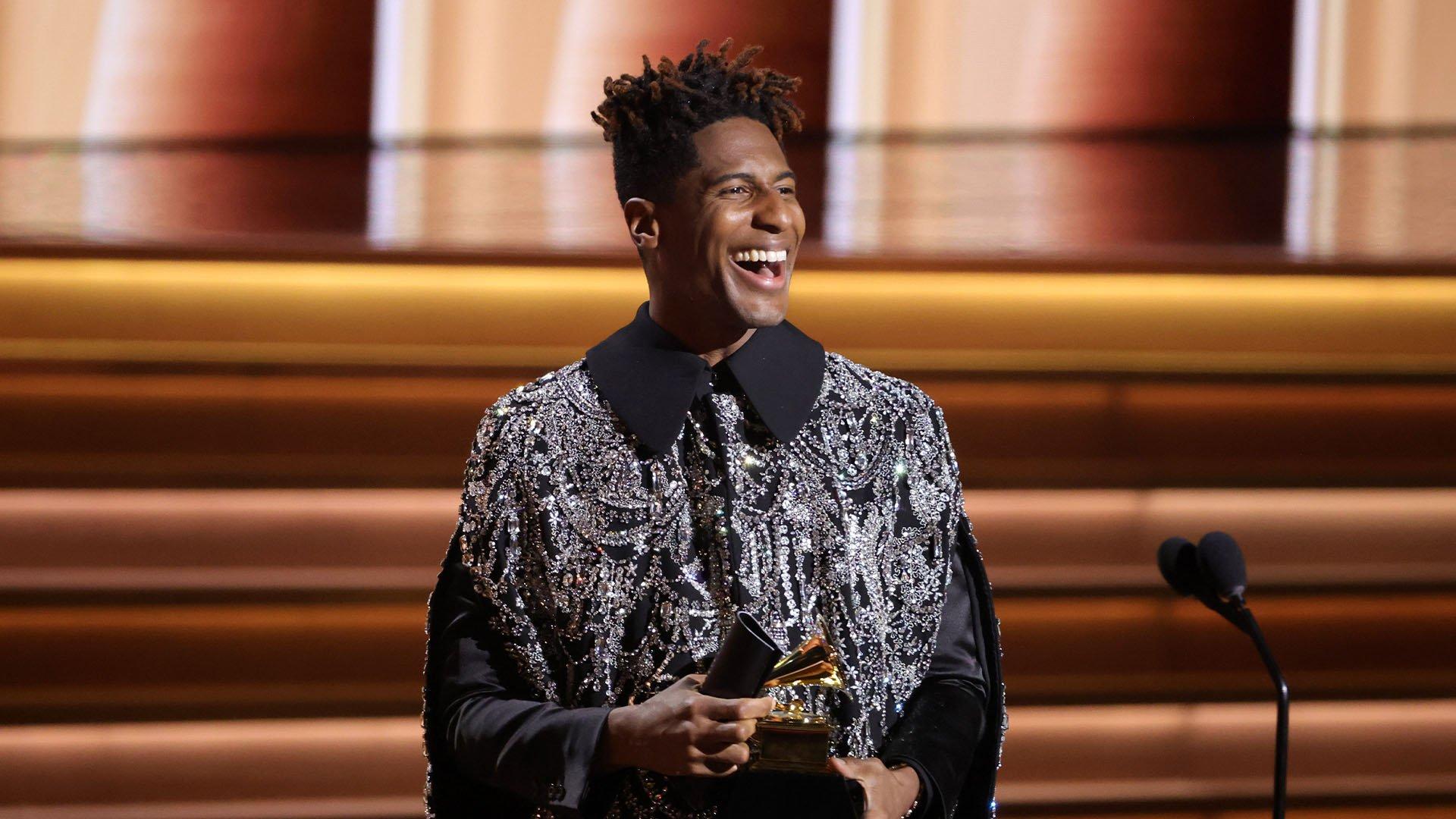
Photo: Matt Winkelmeyer/Getty Images
video
GRAMMY Rewind: Watch Jon Batiste’s Encouraging Speech For His 2022 Album Of The Year Win For 'We Are'
Jon Batiste accepts the Album Of The Year award for We Are, a win that he dedicated to "real artists, real musicians."
Jon Batiste walked into the 2022 GRAMMYs with a whopping 11 nominations, making him the most recognized artist of the evening. By the end of the night, he received five GRAMMYs for Best American Roots Performance, Best American Roots Song, Best Score Soundtrack For Visual Media, Best Music Video, and the highly coveted Album Of The Year.
In this episode of GRAMMY Rewind, watch Batiste take the stage to accept the award for Album Of The Year for his sixth studio album, We Are
Batiste began his praises by acknowledging God: "I just put my head down and work on the craft every day. I love music, he said. "I've been playing since I was a little boy. It's more than entertainment for me — it's a spiritual practice." He also thanked the "many people that went into making this album," including his grandfather, nephew, father, and executive producer, Ryan Lynn.
"This [award] is for real artists, real musicians. Let's just keep going. Be you! That's it. I love you even if I don't know you," Batiste cheered.
Press play on the video above to hear Jon Batiste's complete acceptance speech and check back to GRAMMY.com for more new episodes of GRAMMY Rewind.
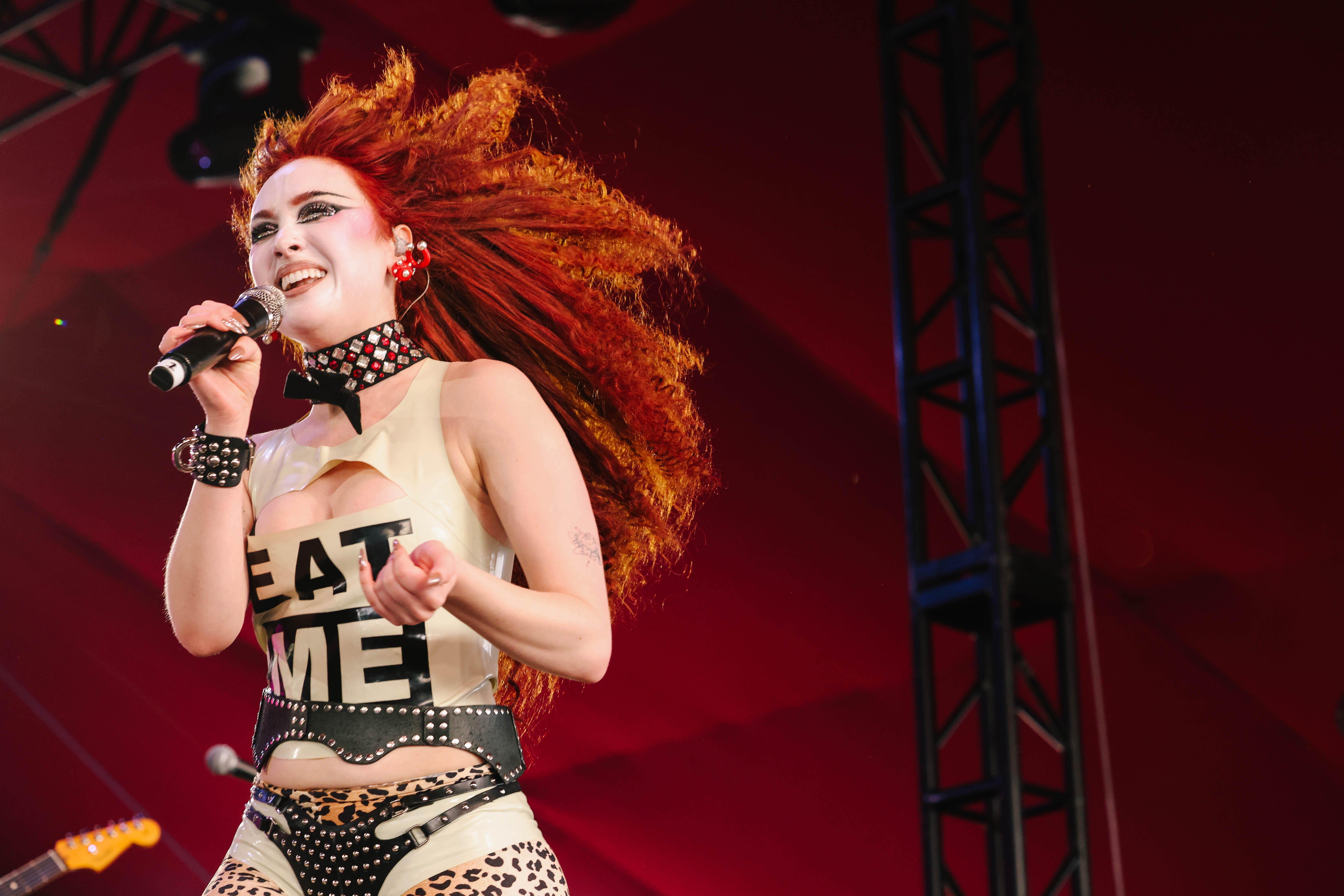
Photo: Dania Maxwell / Los Angeles Times via Getty Images
interview
Chappell Roan's Big Year: The 'Midwest Princess' Examines How She Became A Pop "Feminomenon"
Just after Chappell Roan made her festival debut at Coachella, hear from the pop starlet about some of the defining moments of her career thus far — and how it all helped earn her a spot at one of music's biggest fests.
Before this year, Chappell Roan had never even been to Coachella. Now, not only can she say she's attended — she's performed in the desert, too.
Roan played an evening set on the Gobi Stage on April 12, and is set to return for Weekend 2. Fans clad in everything from cowboy boots, Sandy Liang-inspired bows and, perhaps most importantly, jorts, gathered to celebrate their shared love of Roan's radiance, karmic kink and gay cowgirl doctrine.
Throughout her performance, bubbles breezed through the air as Roan belted out her infectious (and aptly titled) track "Femininomenon," which speaks to lover girls forced to live in an online-dating hellscape. "Ladies, you know what I mean?/ And you know what you need and so does he/ But does it happen? No!" Following collective screams of pure joy, the already enlivened crowd roused to match Roan beat-for-beat, shouting back in perfect unison, "Well, what we really need is a femininomenon!"
In an era of bedroom pop and sad-girl music, Roan has been hailed by both critics and fans for bringing fun back to pop music. Along with her staunch sense of self, Roan's penchant for explicit lyrics that are equally parts introspective and horny makes her dance-pop anthems all the more infectious.
Roan's ambitiously experimental debut album, 2023's The Rise and Fall of a Midwest Princess, cemented her status as one of the most exciting pop stars on the rise. While she only recently landed her first single on the Billboard Hot 100 with "Good Luck, Babe!," her rapidly growing fan base — and an opening slot on Olivia Rodrigo's sold-out GUTS World Tour — indicate that she's on her way to superstardom.
Perhaps part of Roan's magic is that it was all on her own terms. After parting ways with her first label, Atlantic Records, she built a loyal following as an independent artist before signing with Island Records last year. Even as a major label artist, she's determined to only do things her way; her indefatigable commitment to her craft — as well as writing her own rules when it comes to fashion and makeup — is precisely why her fans are so enraptured by both her music and persona.
Her fearlessness was on full display during her first Coachella set, where the words emblazoned on her bodysuit read "Eat Me." She talks the talk, and walks the walk (in fabulous, knee-high boots, of course), matching her unabashed aesthetic with equally bold career moves; for one, the openers for her headlining tour are local drag queens.
With eyeliner winged to the heavens, near-perfect vocal stability and fiery curls ablaze, Roan's shimmering Coachella Weekend 1 performance proved that her stage presence is equally dynamic. And if she had any doubters, she had one thing to say to them: "B—, I know you're watching!"
In between rehearsals for her Coachella debut, Roan took a look back on her journey to one of music's most coveted stages. Below, hear from Roan about five of the most impactful milestones in her career — so far.
Releasing Her Debut Album, The Rise And Fall Of A Midwest Princess
I ended up signing [with Island Records in 2023] because this project honestly got too big to be independent anymore. I just wasn't willing to give up anything, any creative control or for any amount of money.
Being an independent artist was really special because I proved to myself that I could do all these hard things that I had never done. I built it with an entire friend group and many, many years of work. So it wasn't just me, but it proved a lot to me.
It proved I can make it through hard circumstances — with no money. You truly can. You do not need a label to do a lot of what an artist's career requires. You don't need a label to put on your own show, or make a music video, or even write a song, or find creative people. You don't need that s—t. I mean, a label is just money, you know? You don't need a lot of money to do this. To make it grow is, I think, where it takes a lot of money. That's what was difficult.
Music allows me to express anything, even things that I've never experienced before. It allows me to express queerness, even if it was only daydreams at that point. It allows me to express parts of me that I'm not even ready to accept yet.
I don't give a f— if you don't f— with the music. You don't have to come to the concert. That's the whole point of it. You don't have to like it. I think throughout the year, I'm like, "What can I get away with?" Because right now it's pretty tame for what it is like to be a gay artist. But I just want to push it to see how far can I go — with the most controversial outfits or things to rile people up. I'm not really afraid to do that.
Having a song [like "Casual] with the lyric, "Knee deep in the passenger seat/ And you're eating me out," and it's being considered to go to radio. That's kind of a big thing to get away with.
It's not even that big of a thing. What's that song? Is it Flo Rida? That's like, "Can you blow my whistle, baby/ whistle baby." Okay, that's obviously about like a f—ing blowjob. [Laughs.] No one cares about that. To me, I'm like, Let's talk about eating out on the radio. I actually think it has to be bleeped, but still, if I can get away with it, that's cool.
Feeling Financial Freedom & Stability
Not making money at all just sucked. But I learned how to do my own makeup and bedazzle and sew a little bit. I think that the scrappiness came from [the idea that] it's scrappy if it's fun.
I think that's what kept me going — because if this wasn't fun, I would not even be here. But it was scrappy and fun, and it was with my friends. It didn't feel dire. I was also just working at a coffee shop, and I was a nanny, and I was working at a donut shop. I was doing part time jobs all on the side too. So it was all just rough [in the beginning].
I have freedom because now [singing] is my full-time job. It provides for me now. As the project grows, I can do bigger shows and be like, I want outfit changes now, and I want more lights, and I want confetti. I can afford confetti now!
It's about expanding the universe in a thoughtful way. And not just like throwing a s— ton of money at things to make things look expensive or wear all this designer s— for no reason.
I just try to look at how we are starting to gain momentum financially and see how can I intentionally use that to, one, pay the team in a way where they're not bare bones anymore, and two, [ask ourselves] how can we honor this project and this album and the queer community? Can we pay drag queens more? Can we bring drag on the road? Now, financially, doors have opened where we can walk through them with love and intention. Just recklessly, throwing money at s— to see if it works.
Opening Olivia Rodrigo's Arena Tour
Olivia [Rodrigo] just asked. It was official, we went through our management. But I was like, Oh my God.
Preparing a 40-minute set is a different vibe than headlining, obviously. You are going out to an audience that is not there for you and doesn't necessarily care if you're there or not.
This is, like, my fourth or fifth artist I've opened for. But for an arena tour, I just needed to gather my nerves. I think that's the difference between any other show. Like, F—, there's 20,000 people out there right now. I've never performed in front of that many people. I don't know what this emotion is, and I just have to tame it right now.
Standing Up For Herself Creatively, Even When There's Pushback
I stand up for myself, I would say, every day. Sometimes, you get this opportunity, a huge opportunity with a lot of money on the table. [Yet,] I'm just like, That just doesn't make sense creatively. That doesn't align with my values. I'm not doing that.
One huge creative decision was I stood up and pushed the entire headlining Midwest Princess tour back to the fall. The album was supposed to come out while we were on tour. I was like, "This is a horrible idea!"
That caused a big ruckus, but it ended up being fine, and I was right. I'm usually right. [Laughs.] It's like a mother with her kid — a mother knows best. I feel like [that] when it comes to the integrity of my project.
I know how it is to not be able to afford a ticket or even f—ing food. A concert ticket, a lot of times, means multiple meals for someone. I get it, I couldn't afford some artists' tickets. That's why it's really important to me to try to keep them as low as I can and my merch as low as I can.
There's pushback of ticket prices being low and we're playing rooms that are so expensive. The fee to even play them is so expensive. So, you have to raise the ticket prices to just even be able to afford to play the room. There's always an argument [with my team] there, every tour. I'm in control of stuff and if I'm saying this is how it's going to be —- it's just going to be that way.
Performing At Coachella For The First Time
[After the first weekend of Coachella] I am feeling very relieved. I was so stressed about many things. How is the outfit going to work? Will the crowd really be engaged? It went so well, I have no qualms with anything. I loved every second of it.
It feels like I am partying with [my fans]. I am not performing to them; I’m performing with them. [I want people to remember] a really fun, freeing show. Very campy but very meaningful too.
4 Ways Olivia Rodrigo's GUTS World Tour Shows A New Side Of The Pop Princess
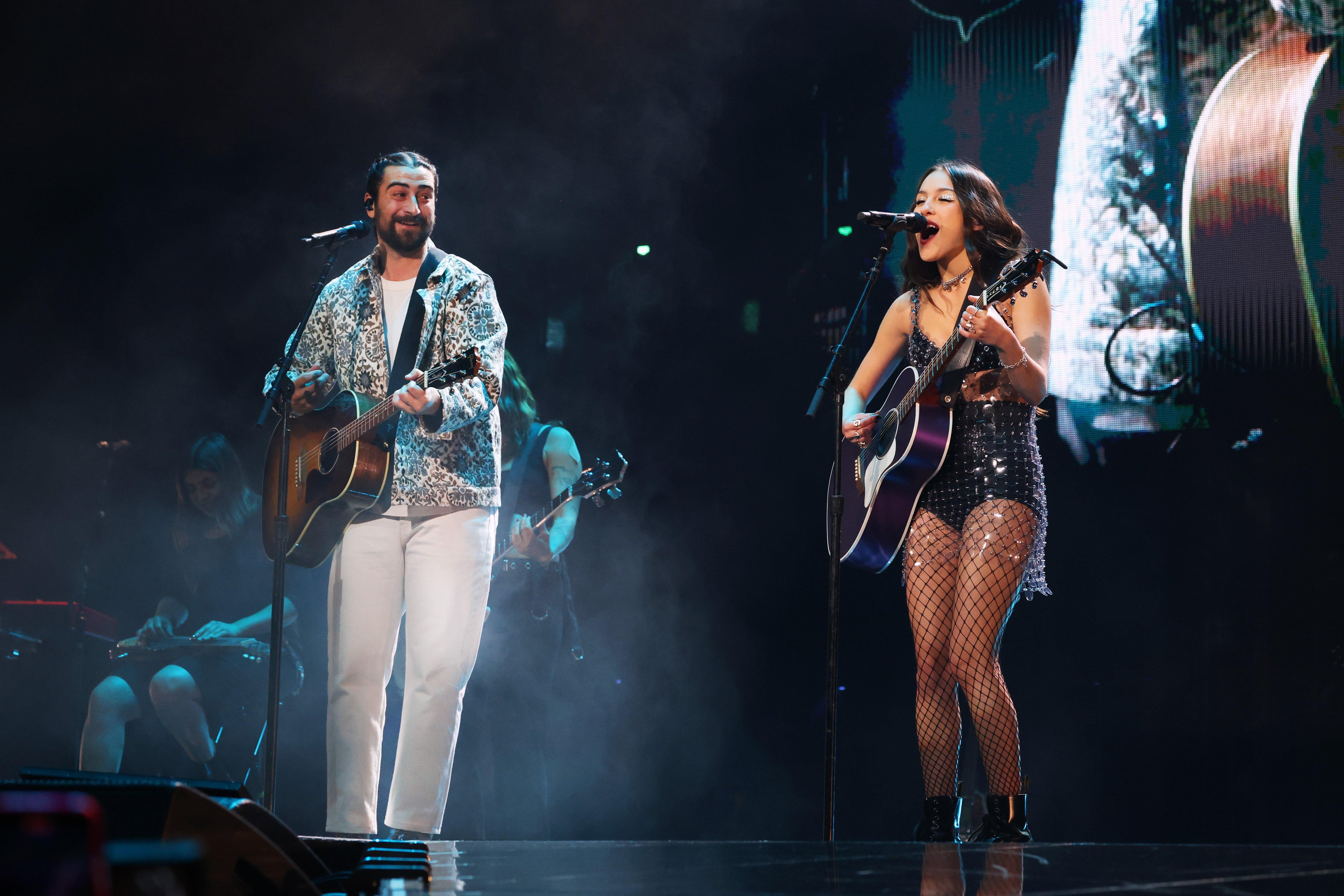
Photo: Kevin Mazur/Getty Images for Live Nation
list
10 Record Store Day 2024 Releases We're Excited About: The Beatles, Notorious B.I.G. & More
In honor of Record Store Day 2024, which falls on April 20, learn about 10 limited, exclusive drops to watch out for when browsing your local participating record store.
From vinyl records by the 1975 and U2, to album reissues and previously unreleased music, record stores around the world are stocking limited and exclusive releases for Record Store Day 2024.
The first Record Store Day kicked off in 2008 and every year since, the event supporting independently owned record stores has grown exponentially. On Record Store Day 2024, which falls on April 20, there will be more than 300 special releases available from artists as diverse as the Beatles and Buena Vista Social Club.
In honor of Record Store Day 2024 on April 20, here are 10 limited and exclusive drops to watch out for when browsing your local participating record store.
David Bowie — Waiting in the Sky (Before The Starman Came To Earth
British glam rocker David Bowie was a starman and an icon. Throughout his career, he won five GRAMMY Awards and was honored with the Lifetime Achievement Award in 2006.
On RSD 2024, Bowie's estate is dialing it back to his Ziggy Stardust days to make Waiting in the Sky (Before The Starman Came To Earth) available for the first time. The record features recordings of Bowie's sessions at Trident Studios in 1971, and many songs from those sessions would be polished for his 1972 album The Rise and Fall of Ziggy Stardust and the Spiders from Mars.
The tracklisting for Waiting in the Sky differs from Ziggy Stardust and features four songs that didn’t make the final album.
Talking Heads — Live at WCOZ 77
New York City-based outfit Talking Heads defined the sound of new wave in the late '70s and into the next decade. For their massive influence, the group received two GRAMMY nominations and was later honored with the Lifetime Achievement Award in 2021.
While promoting their debut album Talking Heads: 77, the quartet recorded a live performance for the New Albany, Pennsylvania radio station WCOZ in 1977. The Live at WCOZ 77 LP will include 14 songs from that performance at Northern Studios, including seven that will be released for the first time. Among the previously unheard cuts are "Love Goes To A Building On Fire" and "Uh-Oh, Love Comes To Town." During that session, Talking Heads also performed songs like "Psycho Killer" and "Pulled Up."
The Doors — Live at Konserthuset, Stockholm, September 20, 1968
The Doors were at the forefront of the psychedelic rock movement of the 1960s and early '70s. One of Jim Morrison's most epic performances with the band will be available on vinyl for the first time.
Live at Konserthuset, Stockholm, September 20, 1968 includes recordings from a radio broadcast that was never commercially released. The 3-LP release includes performances of songs from the Doors’ first three albums, including 1967’s self-titled and Strange Days. In addition to performing their classics like "Light My Fire" and "You're Lost Little Girl," the Doors and Morrison also covered "Mack the Knife" and Barret Strong's "Money (That's What I Want)" live during this session.
Dwight Yoakam — The Beginning And Then Some: The Albums of the '80s
Over the course of his 40-year career, country music icon Dwight Yoakam has received 18 GRAMMY nominations and won two golden gramophones for Best Male Country Vocal Performance in 1994 and Best Country Collaboration with Vocals in 2000.
On Record Store Day 2024, Yoakam will celebrate the first chapter of his legacy with a new box set: The Beginning And Then Some: The Albums of the '80s. His debut album Guitars, Cadillacs, Etc., Etc. and 1987’s Hillbilly Deluxe will be included in the collection alongside exclusive disc full of rarities and demos. The 4-LP set includes his classics like "Honky Tonk Man," "Little Ways," and "Streets of Bakersfield." The box set will also be available to purchase on CD.
The Beatles — The Beatles Limited Edition RSD3 Turntable
Beatlemania swept across the U.S. following the Beatles’ first appearance on "The Ed Sullivan Show" in February 1964, setting the stage for the British Invasion. With The Beatles Limited Edition RSD3 Turntable, the band will celebrate their iconic run of appearances on Sullivan’s TV program throughout that year.
The box set will include a Beatles-styled turntable and four 3-inch records. Among those records are the hits "I Want To Hold Your Hand," "Till There Was You," "She Loves You," and "I Saw Her Standing There," which the Beatles performed on Sullivan's TV across several appearances.
Among 23 GRAMMY nominations, the Beatles won seven golden gramophones. In 2014, the Recording Academy honored them with the Lifetime Achievement Award.
Olivia Rodrigo and Noah Kahan — From The BBC Radio 1 Live Lounge LP
Olivia Rodrigo and Noah Kahan are two of the biggest pop stars in the world right now — Rodrigo hitting the stage with No Doubt at Coachella and near the end of her global GUTS Tour; Kahan fresh off a Best New Artist nomination at the 2024 GRAMMYs. Now, they're teaming up for the split single From The BBC Radio 1 Live Lounge LP, a release culled from each artist's "BBC Radio 1 Live Lounge" sessions.
The special vinyl release will include Rodrigo's live cover of Kahan's breakout hit "Stick Season." The single also includes Kahan’s cover of Rodrigo’s song "Lacy" from her second album, GUTS. This month, they performed the song live together on Rodrigo’s Guts World Tour stop in Madison Square Garden.
Buena Vista Social Club — Buena Vista Social Club
Influential Cuban group Buena Vista Social Club popularized genres and sounds from their country, including son cubano, bolero, guajira, and danzón. Buena Vista Social Club's landmark self-titled LP won the GRAMMY for Best Tropical Latin Album in 1998.
The following year, a documentary was released that captured two of the band's live performances in New York City and Amsterdam. To celebrate the 25th anniversary of the documentary, the Buena Vista Social Club album will be released on a limited edition gold vinyl with remastered audio and bonus tracks.
Buena Vista Social Club is one of the 10 recordings to be newly inducted into the GRAMMY Hall Of Fame as part of the 2024 inductee class.
Danny Ocean — 54+1
Venezuelan reggaeton star Danny Ocean broke through on a global level in 2016 with his self-produced debut single "Me Rehúso," a heartbreaking track inspired by Ocean fleeing Venezuela due to the country's economic instability and the lover he had left behind.
With "Me Rehúso," Ocean became the first solo Latin artist to surpass one billion streams on Spotify, on the platform with a single song. "Me Rehúso" was included on his 2019 debut album 54+1, which will be released on vinyl for the first time for Record Store Day.
Lee "Scratch" Perry & The Upsetters — Skanking With The Upsetter
Jamaican producer Lee "Scratch" Perry pioneered dub music in the 1960s and '70s. Perry received five GRAMMY nominations in his lifetime, including winning Best Reggae Album in 2003 for Jamaican E.T.
To celebrate the legacy of Perry's earliest dub recordings, a limited edition run of his 2004 album Skanking With The Upsetter will be released on Record Store Day. His joint LP with his house band the Upsetters will be pressed on transparent yellow vinyl. Among the rare dub tracks on the album are "Bucky Skank," "Seven & Three Quarters (Skank)," and "IPA Skank."
Notorious B.I.G. — Ready To Die: The Instrumentals
The Notorious B.I.G. helped define the sound of East Coast rap in the '90s. Though he was tragically murdered in 1997, his legacy continues to live on through his two albums.
During his lifetime, the Notorious B.I.G. dropped his 1994 debut album Ready to Die, which is widely considered to be one of the greatest hip-hop releases of all-time. In honor of the 30th anniversary of the album (originally released in September '94), his estate will release Ready To Die: The Instrumentals. The limited edition vinyl will include select cuts from the LP like his hits "Big Poppa," "One More Chance/Stay With Me," and "Juicy." The album helped him garner his first GRAMMY nomination in 1996 for Best Rap Solo Performance. The Notorious B.I.G. received an additional three nominations after his death in 1998.
10 Smaller Music Festivals Happening In 2024: La Onda, Pitchfork Music Fest, Cruel World & More
